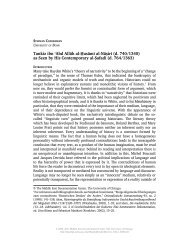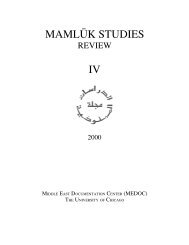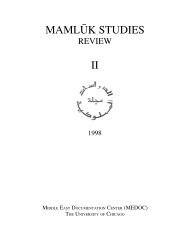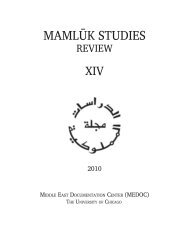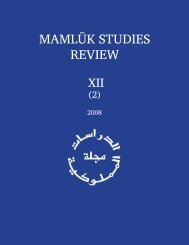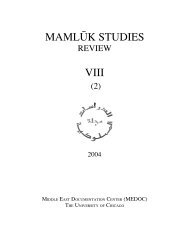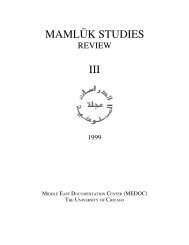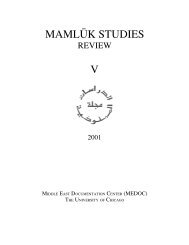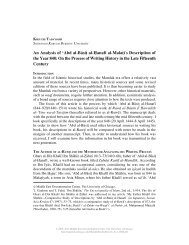Mamluk Studies Review Vol. VI (2002)
Mamluk Studies Review Vol. VI (2002)
Mamluk Studies Review Vol. VI (2002)
Create successful ePaper yourself
Turn your PDF publications into a flip-book with our unique Google optimized e-Paper software.
2 W. W. Clifford, HAARMANN AND MAMLUK STUDIES<br />
Jacob Grimm, and Franz Bopp. Indeed, theoretical advances in historical linguistics<br />
have often foreshadowed the development of related ideas in social and cultural<br />
anthropology. 5 Thus, while Haarmann praised the philologist Helmut Ritter, best<br />
known perhaps for his association with Bibliotheca Islamica, as "the most important<br />
German Orientalist of our century," he also acknowledged the singular achievement<br />
of Carl Heinrich Becker in introducing critical method into the study of Islamic<br />
history. 6 One-time Prussian Minister of Culture and a founding father of Der<br />
Islam, Becker argued that Islamic cultural systems were capable of producing<br />
dynamic socioeconomic change. His adaptation of the idea of "cultural circles"—the<br />
grouping of related cultural traits derived from the Kulturkreis theory prominent<br />
in contemporary mitteleuropäisch ethnology and anthropogeography—seems to<br />
have been particularly revelatory to Haarmann, for whom Sozialgeschichte seems<br />
to have been largely the product of Kultur anyway. Certainly, his belief in a<br />
pre-logical concept like the kollektiv Bewusstsein der Zeit as a source of historical<br />
change invokes the same <strong>Vol</strong>ksgeist of the Kulturkreis—the fundamental psychic<br />
principle shaping the traits of the "cultural circle." 7 Indeed, Haarmann's cataloging<br />
of the various traits of the awla≠d al-na≠s could be interpreted as an effort at<br />
decoding their Weltanschauung, another configurative concept of Austro-German<br />
culture-area theory. 8<br />
Empowered by the synergistic relationship between Philiologie and<br />
Kulturgeschichte, Haarmann came to notice in <strong>Mamluk</strong> historical texts how a<br />
relatively small, discrete social group—awla≠d al-na≠s—occupied a unique and<br />
strategic nexus in <strong>Mamluk</strong> civilization, bridging the cultural interstices between<br />
the alien-extracted umara≠’ (their own fathers) and the indigenous ulama (their<br />
colleague/competitors). The lack of meaningful scholarship about these people, he<br />
believed, was the outcome chiefly of an historiographical bottleneck created initially<br />
in the medieval period by "non-<strong>Mamluk</strong> scholars" attempting to communicate<br />
what they believed was the cultural irrelevance of the na≠s and awla≠d al-na≠s.<br />
Haarmann sought actively to counteract the "bias" he detected in this discursive,<br />
ulama-authored literature by drawing attention to the importance of more objective<br />
archival materials. 9<br />
5<br />
Alan Barnard, History and Theory in Anthropology (Cambridge, 2000), 48.<br />
6<br />
Haarmann, "L'orientalisme allemand," MARS: Le Monde Arabe dans la Recherche Scientifique/The<br />
Arab World in Scientific Research/Al-‘A±lam al-‘Arab| f| al-Bah˝th al-‘Ilm| 4 (1994): 75.<br />
7<br />
Haarmann, "Einleitung," in Geschichte der arabischen Welt, ed. Ulrich Haarmann (Munich,<br />
1987), 10.<br />
8<br />
Barnard, History and Theory, 50–51.<br />
9<br />
Haarmann, "Arabic in Speech," 81.<br />
© <strong>2002</strong>, 2012 Middle East Documentation Center, The University of Chicago.<br />
http://mamluk.uchicago.edu/<strong>Mamluk</strong><strong>Studies</strong><strong>Review</strong>_<strong>VI</strong>_<strong>2002</strong>.pdf



